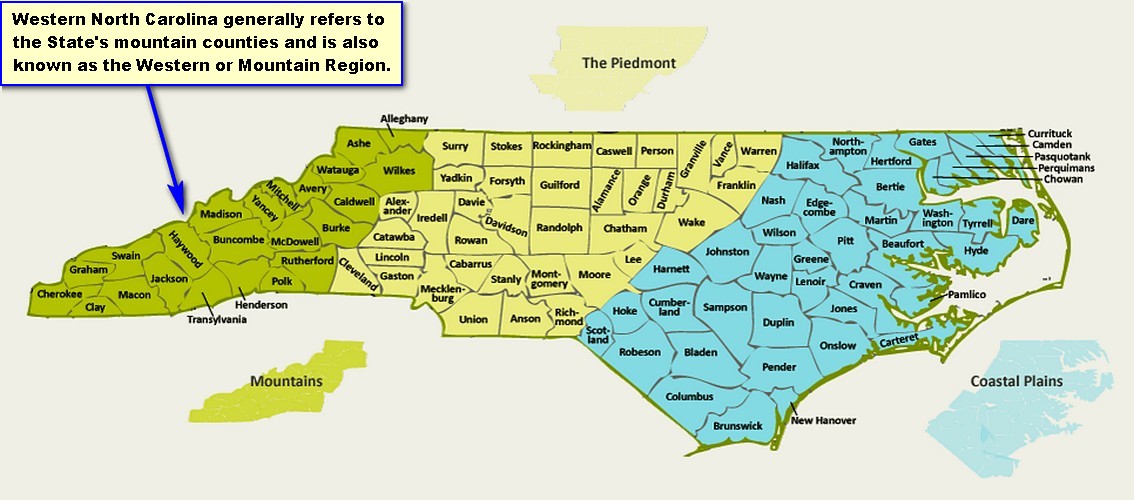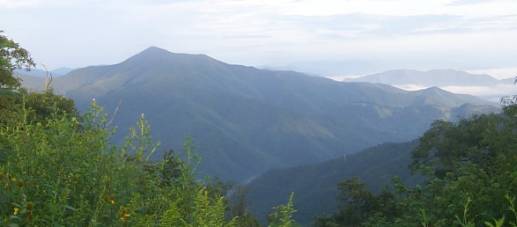|
| Western North Carolina History |

|
| History of Western North Carolina |
HISTORY OF WESTERN NORTH CAROLINA (WNC)
The three landforms of North Carolina account for its three major geographic
regions known as Coastal Plain Region, Piedmont Region, and Mountain Region. Western North Carolina and East Tennessee
co-host the Great Smoky Mountains, which form a portion of the Blue Ridge Mountains and are a subrange of the Appalachian
Mountains.
While Western North Carolina, commonly referred to as WNC, is known as the Mountain
Region, it is smaller in area than the Piedmont and Coastal Plain. The elevation in this rugged terrain soars to
more than one mile high, and the larger Blue Ridge Mountains separate the Piedmont from the Mountain Region. Other ranges
in this landform include the Bald, Balsam, Black, Brushy, Great Smoky, Iron, Pisgah, Stone, and Unaka. All of these ranges
form a portion of the larger Appalachian Mountains, which possibly is the oldest mountains in the United States. Western
North Carolina has at least 40 mountains that rise to 6,000 feet and 100 that rise to more than 5,000 feet. Mount Mitchell
in the Black Mountain range is 6,684 feet high, making it the highest point in North Carolina and the highest in the United
States east of the Mississippi River. The Eastern Continental Divide runs east from those flowing west. Rivers on the eastern
side of the divide flow east toward the Atlantic Ocean. Rivers that run on the western side of the divide flow toward the
Tennessee and Ohio rivers and into the Gulf of Mexico.
| View of Scenic "Cold Mountain" |

|
| NPS |
Editor's Recommended
Reading: Western North Carolina: A History from 1730 to 1913 (Hardcover)
(679 pages). Description: From the introduction to the appendix, this volume
is filled with interesting information. Covering seventeen counties—Alleghany, Ashe, Avery, Buncombe, Cherokee, Clay,
Graham, Haywood, Henderson, Jackson, Macon, Madison, Mitchell, Swain, Transylvania, Watauga, and Yancey—the author conducted
about ten years searching and gathering materials. Continued below...
About the Author: John Preston Arthur was born in
1851 in Columbia, South Carolina. After relocating to Asheville, North Carolina, in 1887, he was appointed Secretary of the
Street Railway Company, and subsequently the Manager and Superintendent until 1894. Later, after becoming a lawyer, he
was encouraged by the Daughters of the American Revolution (D.A.R.) to write a history of western North Carolina.
Recommended Reading:
Touring the Western North Carolina Backroads (Touring the Backroads).
Editorial Review: This guidebook, unlike most, is so encyclopedic in scope that I give it as a gift to newcomers to the area.
It is also an invaluable reference for the visitor who wants to see more than the fabulous Biltmore Estate. Even though I
am a native of the area, I learned nearly everything I know about Western North Carolina
from this book alone and it is my primary reference. I am still amazed at how much fact, history and folklore [just enough
to bring alive the curve of the road, the odd landmark, the abandoned building] is packed in its 300 pages. The author, who
must have collapsed from exhaustion when she finished it, takes you on a detailed tour, laid out by the tenth of the mile,
of carefully drawn sections of backroads that you can follow leisurely without getting lost. Continued below...
The author
is completely absent from the text. The lucid style will please readers who want the facts, not editorial comment. This book,
as well as the others in this publisher's backroads series, makes an excellent gift for anyone, especially the many seniors
who have relocated, or are considering relocating to this fascinating region. It is also a valuable reference for natives,
like me, who didn't know how much they didn't know.
Recommended Viewing: Hillbilly: The Real Story
(2008) (The History Channel). Description: Join host Billy Ray Cyrus on a journey into the hollers and runs of Appalachia to discover the
proud legacy of the region's mountain folk. Learn how hillbillies, long misunderstood and maligned as isolated and backward,
actually have a 300-year history of achievement and success that has contributed significantly to our national identity. In
this two-hour special you'll meet outcast immigrants, war heroes, isolated backwoodsmen, hard working miners, fast moving
moon shiners, religious warriors, musicians and statesmen. Continued below...
You'll learn
of their contributions, which include establishing the first labor unions, battling the British, and spawning some of the
most popular aspects of American culture today, like NASCAR and country music. And you'll see them in a whole new light. “The numerous candid interviews highlight this outstanding addition.”
See also a
list of additional 'must-read picks' for Western North Carolina and Southern Appalachia.
The numerous
links on this page offer additional information regarding North Carolina History: NC history and events, a rare photo that
may catch your eye, museum photos, the State flag picture, pictures from pre-statehood to the present-day. Some have
contributed an old cherished photograph, and others have submitted vintage photographs of beautiful waterfalls,
scenic rivers, mountain homes, from the colonial era, antebellum and even progressive eras. Some information is from
an encyclopedia, while additional facts are from various encyclopedias. Historical timeline summary may be applied to some
pages, but references and sources (primary and secondary) will be on the specific page. There are several historical
timelines that discuss, year by year, the history of a specific area or region. Famous people from the date of statehood,
many with that so-called pic (or pics) with summary, to "average persons" that have contributed vital facts to the
state's existence may also be located through the internal search engine or via enclosed link. (If you are into genealogy,
there is a section on "How to get started in researching ancestors.) All material, unless otherwise stated, may be used
for 'classroom students' at no charge. Feel free to use without contacting us. If you have a question about North Carolina,
the who, what, where, when, why, and how, you are at the right place! We hope that you enjoy the mountain, Piedmont, and coastal
(the 3 regions that represent the state) facts, data, and related information of our historical state -- the Old
North State, the Tar Heel State.
|

